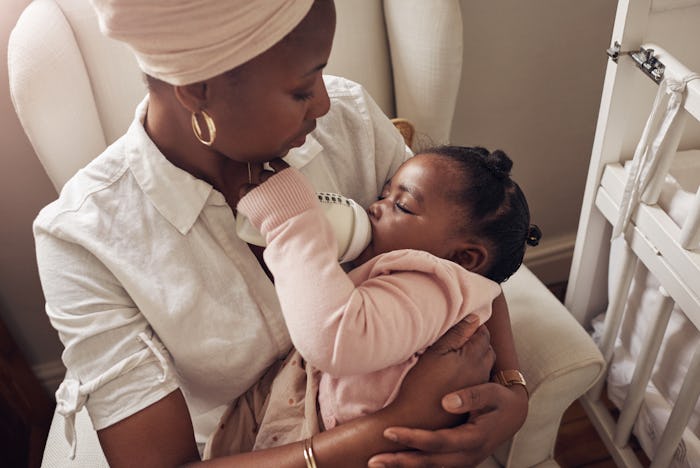Baby

What You Need To Know About Giving Your Baby Cold Breast Milk
When your baby is crying for food, do you really have to take the time to heat it?
How many sleepless nights has a breastfeeding mom or dad stood at the refrigerator, screaming baby in their arms, wondering if they really have to heat up that bottle before feeding their little one? In all honesty, it's crossed every parent's mind to just give a baby cold breast milk, whether they're on the go without a warmer or just exhausted. But what happens if you do?
Since breast milk has to be stored in the fridge, it’s totally normal to wonder whether your baby needs their bottle warmed up before feeding (or, if they’re in the middle of a hangry tantrum, if they can safely drink it chilled). Many moms dedicate themselves to breastfeeding and pumping to make sure their baby is getting all those nutrients known to exist in breast milk, so it’s important to know how temperature affects the milk. Spoiler alert: it can mess with the milk’s healthy fats.
If you’re wondering if you can give your baby cold breast milk, the short answer is actually yes, according to breastfeeding experts. In doing so, however, it's important to know that there are a few factors or problems you may run into. Although it is generally safe and healthy for moms to give their babies cold breast milk, it can present some challenges, like not being your baby’s favorite way to enjoy a midnight beverage.
1
Your Baby Might Be Surprised
Many people have taken a drink expecting one thing and gotten something completely different. The shocked reaction is the same for babies who may be expecting a warm bottle when they first take a sip of cold breast milk.
“Babies may be surprised with the cold milk at first, so it may be a good idea to have the baby get accustomed to cooler milk rather than straight out of the refrigerator at 3 a.m., especially if the baby is used to body temperature breast milk from mom,” says Lisa Hays, BSN, IBCLC, lactation consultant at Baptist Medical Center South, in an interview with Romper. “Perhaps gradually begin giving baby cooler milk with less heating so he gets used to it first.”
2
The Fat Layer May Not Mix Well
Jody Segrave-Daly, IBCLC and co-founder of The Fed Is Best Foundation, tells Romper in an interview that, in cold milk, the fat can separate from the rest of the liquid. Those calories are important for babies, so it’s best to eyeball your breast milk and make sure everything is mixed together well.
“The fat in breast milk will adhere to the sides of the bottle and your baby may not receive all the calories he needs,” says Segrave-Daly. “I think breast milk should be at least run under hot water to release the fat that adheres to the container's side. Giving it a gentle swirl will also help disperse the fat. We want babies, especially younger babies who rely on breast milk nutrition exclusively, to receive as much fat as possible from the container.”
3
Your Baby May Refuse It, Or Drink Less
If your baby is really uncomfortable or just not used to cold breast milk, they may refuse the bottle at first or drink less. Healthline noted that some babies may just prefer warmer milk that's closer to body temperature. If this is the case, you can try introducing milk to your baby at a slightly cooler temperature, gradually, until they're used to it.
“I also know babies have a preference for the milk temperature and they will quickly tell you if they like it,” says Segrave-Daly. “I think it’s important to educate parents about how to take the chill off and how to appropriately warm up milk to preserve the integrity of its composition. According to recent research, ‘breast milk is composed of cells, nutrients, and proteins beneficial to neonates, it is undoubtedly important for milk to be handled and upheld appropriately so that all components are functional, intact, and viable.’”
If your baby is accustomed to drinking cool milk, or just doesn’t mind it even if it’s their first time, feeding them refrigerated milk could be a totally normal process.
“There is no scientific basis to the idea that cold milk would upset a baby's stomach more than warmed milk,” says Hays. “Per the Centers for Disease Control and Prevention, breast milk does not need to be warmed. It can be served at room temperature or cold.”
“Cold breast milk is absolutely safe. Older babies can absolutely enjoy a breast milk popsicle for teething or a summertime treat,” adds Segrave-Daly.
Both of these experts agree that the only time you may really need to warm up your breast milk is if your baby has certain health risks. Or, you know, just if it’s chilly outside.
“Depending on the seasons, like wintertime and the baby's age, infants especially may struggle to keep a warm core body temperature,” says Segrave-Daly.
“The Human Milk Banking Association advocates warming milk to body temperature for premature infants, particularly those at risk for necrotizing enterocolitis,” says Hays. “For term infants, feedings may be given at body temperature, room temperature, or straight from the refrigerator.” If you do decide to warm it, make sure to do it safely. Don't microwave your breast milk, and instead pop the bottle into a warmer or other container of warm water for it to heat up.
Experts:
Lisa Hays, BSN, IBCLC, lactation consultant at Baptist Medical Center South
Jody Segrave-Daly RN, MS, IBCLC, co-founder of The Fed Is Best Foundation
This article was originally published on